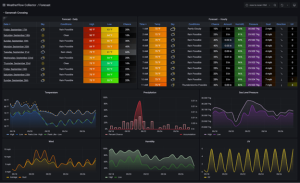
Harnessing Data for Enhanced Micro-Climate Monitoring in Fujairah
The Emirate of Fujairah, with its unique mountainous landscape, stands apart in the United Arab Emirates for its distinct climate. According to Köppen and Geiger classification as a hot desert climate (BWh), Fujairah experiences limited rainfall and high temperatures, especially from May to September, where temperatures can exceed 40°C. However, these broad characteristics do not fully capture the nuanced climatic variations from the coastline to the mountainous inland, highlighting the need for a sophisticated approach to climate monitoring.
At the heart of Fujairah’s climate monitoring endeavors is a network of weather stations overseen by the National Center for Meteorology. These stations are critical in gathering a wide array of environmental data points such as temperature, humidity, precipitation, and wind speed. This detailed information provides a comprehensive understanding of the region's climate dynamics.
Fujairah’s climate monitoring techniques represent a fusion of technology and environmental science: Remote Sensing: Utilizing satellite imagery and aerial surveys, remote sensing offers a macroscopic perspective of climatic conditions. This technology is vital for tracking weather patterns over time and space.
Automated Sensor Networks: Deployed across various locations, these sensors provide real-time data, crucial for both long-term climate studies and immediate weather forecasting. Data Analytics: Big data tools and machine learning algorithms are employed to translate vast amounts of raw data into actionable insights. This enables the development of predictive models that can forecast weather anomalies with increased accuracy. Climate Modelling: Advanced computer models simulate Fujairah’s micro-climatic conditions, considering the diverse topography and coastal influences to predict future climate scenarios.
The Fujairah Research Centre is spearheading an ambitious project to augment the weather monitoring network by adding 40 more weather stations across the Emirate. This expansion is critical for several reasons. Improved Forecasting Accuracy: The additional stations will provide more data points, leading to more precise weather forecasts. This is particularly important for agriculture, where accurate weather information is essential for crop planning and water resource management. In-depth Microclimate Studies: With a broader data collection network, researchers can gain a deeper understanding of the microclimate variations within the Emirate. This information is invaluable for urban planning and designing infrastructure resilient to climatic stressors. Enhanced Disaster Preparedness: Reliable weather predictions are key in preparing for extreme weather events, thus reducing potential damage and safeguarding communities.
The advantages of weather monitoring and forecasting are manifold: Agricultural Advancements: Precise weather forecasts allow farmers to make well-informed decisions regarding planting, irrigation, and harvesting, leading to optimized crop yields and efficient resource utilization. Strategic Urban Planning: Detailed climate data informs the design of buildings and infrastructure, ensuring resilience to climate-related challenges. Public Safety and Disaster Management: Accurate weather forecasts are crucial in disaster preparedness, significantly mitigating the impact of extreme weather events on populations.
Understanding microclimates is crucial in regions like Fujairah. Microclimate studies reveal the small-scale variations in climate within a given area, often influenced by local geography and topography. These studies are particularly relevant in mountainous regions where elevation, orientation, and other factors can create diverse microclimates even within short distances. Impact on Biodiversity: Microclimates can affect the distribution of plant and animal species, impacting the overall biodiversity of the region. Agricultural Implications: Knowledge of microclimates aids in the selection of suitable crops and agricultural practices tailored to specific areas. Urban Heat Islands: In urban areas, microclimate studies help in understanding and mitigating the urban heat island effect, leading to more sustainable urban living environments.
As Fujairah continues to advance its climate monitoring capabilities, the integration of emerging technologies like AI and IoT (Internet of Things) is anticipated. These technologies can provide even more precise and real-time data, enhancing predictive models and climate simulations. AI in Weather Prediction: AI algorithms can analyze complex climate data sets, improving the accuracy of weather forecasts and climate models. IoT in Environmental Monitoring: IoT devices can offer continuous, real-time monitoring of environmental parameters, providing valuable data for environmental management and policymaking.
Fujairah’s commitment to advanced climate monitoring and the expansion of its weather station network marks a significant step in understanding and managing complex environmental systems. Embracing a data-centric approach, the Emirate not only enhances its climate resilience but also sets an example for other regions with similar climatic challenges.
